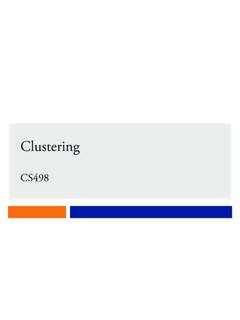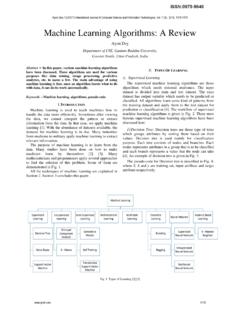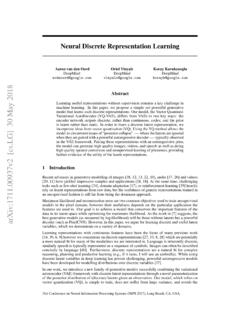Transcription of arXiv:1511.06434v2 [cs.LG] 7 Jan 2016
1 Under review as a conference paper at ICLR 2016 UNSUPERVISEDREPRESENTATIONLEARNINGWITHDE EPCONVOLUTIONALGENERATIVEADVERSARIALNETW ORKSAlec Radford & Luke Metzindico ResearchBoston, ChintalaFacebook AI ResearchNew York, recent years, supervised learning with convolutional networks (CNNs) hasseen huge adoption in computer vision applications. Comparatively, unsupervisedlearning with CNNs has received less attention. In this work we hope to helpbridge the gap between the success of CNNs for supervised learning and unsuper-vised learning . We introduce a class of CNNs called deep convolutional generativeadversarial networks (DCGANs), that have certain architectural constraints, anddemonstrate that they are a strong candidate for unsupervised learning . Trainingon various image datasets, we show convincing evidence that our deep convolu-tional adversarial pair learns a hierarchy of representations from object parts toscenes in both the generator and discriminator.
2 Additionally, we use the learnedfeatures for novel tasks - demonstrating their applicability as general image reusable feature representations from large unlabeled datasets has been an area of activeresearch. In the context of computer vision, one can leverage the practically unlimited amount ofunlabeled images and videos to learn good intermediate representations, which can then be used ona variety of supervised learning tasks such as image classification. We propose that one way to buildgood image representations is by training Generative Adversarial Networks (GANs) (Goodfellowet al., 2014), and later reusing parts of the generator and discriminator networks as feature extractorsfor supervised tasks. GANs provide an attractive alternative to maximum likelihood can additionally argue that their learning process and the lack of a heuristic cost function (suchas pixel-wise independent mean-square error) are attractive to representation learning .
3 GANs havebeen known to be unstable to train, often resulting in generators that produce nonsensical has been very limited published research in trying to understand and visualize what GANslearn, and the intermediate representations of multi-layer this paper, we make the following contributions We propose and evaluate a set of constraints on the architectural topology of ConvolutionalGANs that make them stable to train in most settings. We name this class of architecturesDeep Convolutional GANs (DCGAN) We use the trained discriminators for image classification tasks, showing competitive per-formance with other unsupervised algorithms. We visualize the filters learnt by GANs and empirically show that specific filters havelearned to draw specific [ ] 7 Jan 2016 Under review as a conference paper at ICLR 2016 We show that the generators have interesting vector arithmetic properties allowing for easymanipulation of many semantic qualities of generated FROM UNLABELED DATAU nsupervised representation learning is a fairly well studied problem in general computer visionresearch, as well as in the context of images.
4 A classic approach to unsupervised representationlearning is to do clustering on the data (for example using K-means), and leverage the clusters forimproved classification scores. In the context of images, one can do hierarchical clustering of imagepatches (Coates & Ng, 2012) to learn powerful image representations. Another popular methodis to train auto-encoders (convolutionally, stacked (Vincent et al., 2010), separating the what andwhere components of the code (Zhao et al., 2015), ladder structures (Rasmus et al., 2015)) thatencode an image into a compact code, and decode the code to reconstruct the image as accuratelyas possible. These methods have also been shown to learn good feature representations from imagepixels. Deep belief networks (Lee et al., 2009) have also been shown to work well in learninghierarchical NATURAL IMAGESG enerative image models are well studied and fall into two categories: parametric and non-parametric models often do matching from a database of existing images, often matchingpatches of images, and have been used in texture synthesis (Efros et al.)
5 , 1999), super-resolution(Freeman et al., 2002) and in-painting (Hays & Efros, 2007).Parametric models for generating images has been explored extensively (for example on MNIST digits or for texture synthesis (Portilla & Simoncelli, 2000)). However, generating natural imagesof the real world have had not much success until recently. A variational sampling approach togenerating images (Kingma & Welling, 2013) has had some success, but the samples often sufferfrom being blurry. Another approach generates images using an iterative forward diffusion process(Sohl-Dickstein et al., 2015). Generative Adversarial Networks (Goodfellow et al., 2014) generatedimages suffering from being noisy and incomprehensible. A laplacian pyramid extension to thisapproach (Denton et al., 2015) showed higher quality images, but they still suffered from the objectslooking wobbly because of noise introduced in chaining multiple models.
6 A recurrent networkapproach (Gregor et al., 2015) and a deconvolution network approach (Dosovitskiy et al., 2014) havealso recently had some success with generating natural images. However, they have not leveragedthe generators for supervised THE INTERNALS OFCNNSOne constant criticism of using neural networks has been that they are black-box methods, with littleunderstanding of what the networks do in the form of a simple human-consumable algorithm. In thecontext of CNNs, Zeiler et. al. (Zeiler & Fergus, 2014) showed that by using deconvolutions andfiltering the maximal activations, one can find the approximate purpose of each convolution filter inthe network. Similarly, using a gradient descent on the inputs lets us inspect the ideal image thatactivates certain subsets of filters (Mordvintsev et al.)
7 3 APPROACH ANDMODELARCHITECTUREH istorical attempts to scale up GANs using CNNs to model images have been unsuccessful. Thismotivated the authors of LAPGAN (Denton et al., 2015) to develop an alternative approach to it-eratively upscale low resolution generated images which can be modeled more reliably. We alsoencountered difficulties attempting to scale GANs using CNN architectures commonly used in thesupervised literature. However, after extensive model exploration we identified a family of archi-2 Under review as a conference paper at ICLR 2016tectures that resulted in stable training across a range of datasets and allowed for training higherresolution and deeper generative to our approach is adopting and modifying three recently demonstrated changes to CNN first is the all convolutional net (Springenberg et al.)
8 , 2014) which replaces deterministic spatialpooling functions (such as maxpooling) with strided convolutions, allowing the network to learnits own spatial downsampling. We use this approach in our generator, allowing it to learn its ownspatial upsampling, and is the trend towards eliminating fully connected layers on top of convolutional strongest example of this is global average pooling which has been utilized in state of theart image classification models (Mordvintsev et al.). We found global average pooling increasedmodel stability but hurt convergence speed. A middle ground of directly connecting the highestconvolutional features to the input and output respectively of the generator and discriminator workedwell. The first layer of the GAN, which takes a uniform noise distributionZas input, could be calledfully connected as it is just a matrix multiplication, but the result is reshaped into a 4-dimensionaltensor and used as the start of the convolution stack.
9 For the discriminator, the last convolution layeris flattened and then fed into a single sigmoid output. See Fig. 1 for a visualization of an examplemodel is Batch Normalization (Ioffe & Szegedy, 2015) which stabilizes learning by normalizing theinput to each unit to have zero mean and unit variance. This helps deal with training problems thatarise due to poor initialization and helps gradient flow in deeper models. This proved critical to getdeep generators to begin learning , preventing the generator from collapsing all samples to a singlepoint which is a common failure mode observed in GANs. Directly applying batchnorm to all layershowever, resulted in sample oscillation and model instability. This was avoided by not applyingbatchnorm to the generator output layer and the discriminator input ReLU activation (Nair & Hinton, 2010) is used in the generator with the exception of the outputlayer which uses the Tanh function.
10 We observed that using a bounded activation allowed the modelto learn more quickly to saturate and cover the color space of the training distribution. Within thediscriminator we found the leaky rectified activation (Maas et al., 2013) (Xu et al., 2015) to workwell, especially for higher resolution modeling. This is in contrast to the original GAN paper, whichused the maxout activation (Goodfellow et al., 2013).Architecture guidelines for stable Deep Convolutional GANs Replace any pooling layers with strided convolutions (discriminator) and fractional-stridedconvolutions (generator). Use batchnorm in both the generator and the discriminator. Remove fully connected hidden layers for deeper architectures. Use ReLU activation in generator for all layers except for the output, which uses Tanh.


![arXiv:0706.3639v1 [cs.AI] 25 Jun 2007](/cache/preview/4/1/3/9/3/1/4/b/thumb-4139314b93ef86b7b4c2d05ebcc88e46.jpg)
![arXiv:1301.3781v3 [cs.CL] 7 Sep 2013](/cache/preview/4/d/5/0/4/3/4/0/thumb-4d504340120163c0bdf3f4678d8d217f.jpg)
![@google.com arXiv:1609.03499v2 [cs.SD] 19 Sep 2016](/cache/preview/c/3/4/9/4/6/9/b/thumb-c349469b499107d21e221f2ac908f8b2.jpg)










